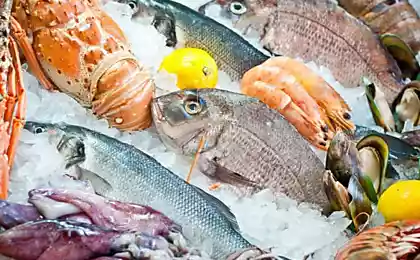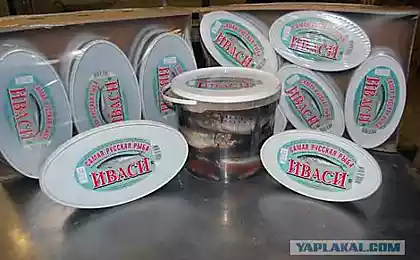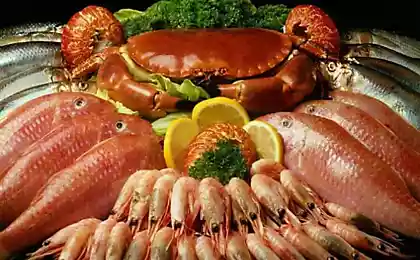1978
Salted fish in Japan
As it has long been the custom of our planet, it all started with the fish. Fish is delicious and useful, but for a long time to eat regularly it could only those who lived near large bodies of water. Gradually people started to learn different ways to preserve it. This made it possible to harvest the fish for the future and send to locations distant from the coast. In Europe was widespread salinity. It is thanks to him that the people tasted the inner regions of marine fish (primarily herring), and the Christians were able to safely do without meat in posts and Friday / Saturday.
In Asia, too, has long been salted fish. But the technology is different from the European one. The fish is cleaned, cut into slices, sprinkle with salt, and then mixed with rice and placed under the press.

Figure ferment lactic acid, a few months later the fish was ready. Turned in the same stinking pasta or rice is thrown, or used for the preservation of the next batch of fish.
Came up with this method, most likely in Southeast Asia, on the banks of the Mekong River. Figure there was a main meal, and fish breeding, including in the flooded fields, where he grew up. Through the South China Technology got on the Japanese island of Kyushu, and from there spread throughout the country. This occurred not later than the 8th century BC The word "sushi" was named the taste of fermented fish so. Such fish are still prepared and eaten in some parts of Japan. Term of cooking - from the year, and it looks like this:
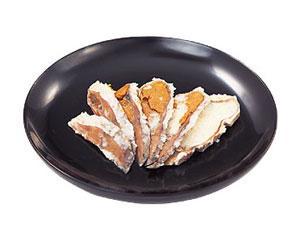
Most of his stories salted fish in Japan was only available aristocracy. The poor had nothing to dream about how to have something for the preparation of what is necessary to spoil a valuable Fig. Around the 16th century elite snack start getting spread among the wealthy and ordinary samurai. Throw rice they were sorry, and dwell time of salted fish in rice began to reduce. Fig thus remained edible, although the shelf life of the food decreased due to incomplete fermentation. The resulting dish called Nama Sushi ANRE:

Japanese chefs continued to experiment. In the 17th century to shorten the cooking and giving special taste began to add rice malt or sake. Then guessed use vinegar. As a result, by the early 19th century cooking time was reduced to 1 day.
In the 19th century, one cook in Edo (now Tokyo) came up with a fresh idea. Since sushi after all these innovations actually ceased to be the product of long-term storage, he abandoned fish processing. The new dish was a little raw fish caught in local bay with boiled rice. Rice seasoned with vinegar and a little salt. Then, except for the fish were used as marine reptiles. New relished gourmets and quickly became one of the trademarks of the largest city of the country. Sushi prepared in restaurants and at home. Dish, which was previously prepared and stored up to a year a few months, suddenly turned into a food that ate freshly prepared, even with minimal processing of the initial components.

Here we must also mention about onigiri or "rice balls". This is also a meal of rice, often filled (quite symbolic to give flavor) and wrapped in dried seaweed. Because of this (and because of the similarity with the name nigiridzusi, which represent the most common type of modern sushi) they are sometimes confused with sushi. Onigiri much more, have a triangular or circular shape.
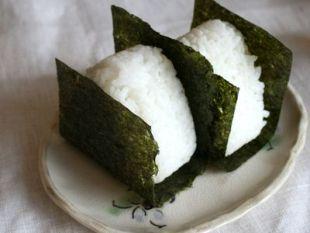
In the life of the Japanese, they have always played a much more important place than sushi. This pies, sandwiches and hiking portion of porridge in a bottle. Breakfast, lunch and dinner for those who do not have to eat at home. Long since they took with them peasants and soldiers in the field in the campaign. Standard soldering - couple kolobkov.Oni and now very common. Each universal 24-hour convenience store (which in Japan is literally on every corner) must sell several kinds of onigiri.
When Edo appeared sushi modern look, they were the size is the same as onigiri - with fist-sized. Two pieces enough to eat. But as a full lunch / dinner they did not use. Rather, it was a local fast food. By the way, while among buyers was taken after a meal to wipe your hands on the front curtain restaurants. Say, the owners institutions specifically they are not washed, to show how their popular restaurants.
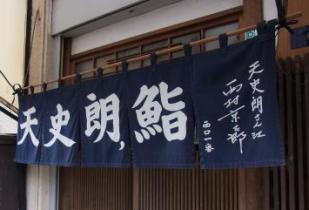
Gradually reduced the amount of servings, and the range of additives to the rice increased. By the way, contrary to popular belief, raw fish among the additives are not prevailed. In addition to raw (or rather slightly marinated in vinegar and salt) is used boiled and steamed fish, caviar, shellfish and other seafood, vegetables, soy products, eggs.
In 1923, Tokyo hit by the worst earthquake in its history. Killed several hundred thousand people. This, by the way, more than the Japanese in the Russian-Japanese war. Material damage from the earthquake is five times the cost of the war. The city was completely destroyed.

As a result, many cooks in search of shelter and work flocked to the province, to the small home. They are spread throughout the country fashion for sushi in Tokyo. In many regions keep their varieties of this dish. However, it is Tokyo sushi was destined to be the hallmark of Japanese cuisine and subsequently to step over the ocean. Same old pressed sushi continued to eat (especially strong position in the west of the country), but they gradually began to fade into the background.
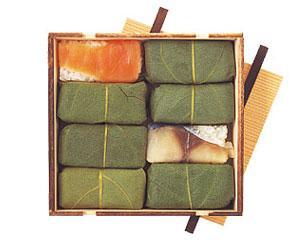
After the war, selling sushi for some time had been banned due to saving mode. Even after the lifting of the ban, they have long been considered an expensive pleasure. Things began to change in 1958, when the Osaka invented conveyor sushi restaurants.
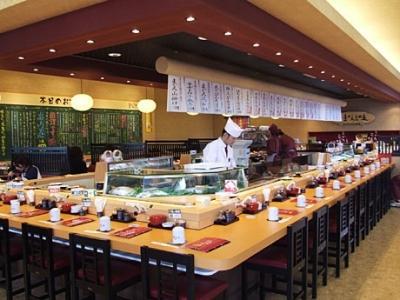
They, and has spread later delivery sushi again turned them into affordable to every meal. While in Japan, almost no one eats them every day (in fact, once a week they eat not everyone), sushi became an integral part of the country. Around susechnyh increased its aura, its own traditions. For example, there There is a special vocabulary. You can often hear the words which the uninitiated, even aborigine not say anything. For example, the word kappa (water) denote cucumber. A word Kusa (Grass) - algae.
In Europe and America, local public rasprobovali sushi in 1953, when the Crown Prince (now Emperor) Akihito traveled the world and treated them any notable people. In the same fashion in the west sushi began to enter into the 70s. Started this hobby on the west coast of the US. The pioneers were people from Hollywood, which turned out to be the best sushi fusion of exotic status (they were expensive), utility (low in fat and high in protein). One of the first fans became my countryman Yul Brynner, in due time shift "Seven Samurai" the American way. Behind him stretched the rest.
The most widely used in the United States got sushi maki (ie wrapped algae) called English-speaking roll, and for filling selected local products. Thus was born, for example, "California" (the name - the place of origin) and a number of other rolls. They became for many of us the embodiment of Japanese food, but actually from Japan, there was only an idea.
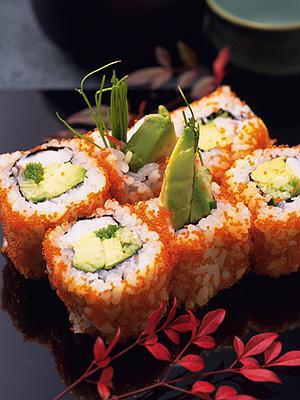
In the 80s, when Japan was the second economic power country in the world (and seriously claimed the first place), the Japanese exotica became even more popular. Sushi boom spread from the US to Europe.
In the late '80s and they got to Moscow, and not from the east and from the west. Enthusiasts have tried to diversify their harsh Soviet catering, but without much success. Strange food was expensive and confusing the masses. European-American origin caused an abundance of rolls on the menu, and the clumsy name of sushi with annoying Yaponisty s sound at the end.
Prices were more democratic in the 90s. At the beginning of the 2000s, when the country poured a stream of oil revenues, residents of large cities have become more willing to give money for all sorts of fancy gadgets. In Moscow, St. Petersburg and other major cities like mushrooms after the rain began to appear sushi bars and Japanese restaurants, as it were. Unlike Chinese restaurants, which usually belong to the Chinese and managed by the same Japanese restaurant in Russia - this is usually the Slavic institution. In the menu, in addition to Japanese food is often a Chinese, and even some barbecue pizza. Well, if there is a Japanese chef. But almost mandatory for a wide range of spacing Uzbeks, Buryat and other nonwhite women.

The main problems of Russian sushi - it's expensive, tasteless and inauthentic. If rice or dried seaweed from Japan to bring a simple task, the fresh fish and seafood - a problem. From Japan, they hardly driven, preferring alternatives (other than to taste and do not possess a marvelous freshness) of Southeast Asia, Norway, etc.
Generally, in terms of availability of products to Russia much more suited other types of Japanese cuisine: different kinds of noodles, soups, Tyahan, okonomiyaki, sukiyaki, kusiyaki, katsudon and so on. However, fashion is fashion. C'est la vie. Or, as the Japanese say, sikata ha nai. But if suddenly fate will bring to Japan, try real sushi. They are worth it.
In Asia, too, has long been salted fish. But the technology is different from the European one. The fish is cleaned, cut into slices, sprinkle with salt, and then mixed with rice and placed under the press.

Figure ferment lactic acid, a few months later the fish was ready. Turned in the same stinking pasta or rice is thrown, or used for the preservation of the next batch of fish.
Came up with this method, most likely in Southeast Asia, on the banks of the Mekong River. Figure there was a main meal, and fish breeding, including in the flooded fields, where he grew up. Through the South China Technology got on the Japanese island of Kyushu, and from there spread throughout the country. This occurred not later than the 8th century BC The word "sushi" was named the taste of fermented fish so. Such fish are still prepared and eaten in some parts of Japan. Term of cooking - from the year, and it looks like this:

Most of his stories salted fish in Japan was only available aristocracy. The poor had nothing to dream about how to have something for the preparation of what is necessary to spoil a valuable Fig. Around the 16th century elite snack start getting spread among the wealthy and ordinary samurai. Throw rice they were sorry, and dwell time of salted fish in rice began to reduce. Fig thus remained edible, although the shelf life of the food decreased due to incomplete fermentation. The resulting dish called Nama Sushi ANRE:

Japanese chefs continued to experiment. In the 17th century to shorten the cooking and giving special taste began to add rice malt or sake. Then guessed use vinegar. As a result, by the early 19th century cooking time was reduced to 1 day.
In the 19th century, one cook in Edo (now Tokyo) came up with a fresh idea. Since sushi after all these innovations actually ceased to be the product of long-term storage, he abandoned fish processing. The new dish was a little raw fish caught in local bay with boiled rice. Rice seasoned with vinegar and a little salt. Then, except for the fish were used as marine reptiles. New relished gourmets and quickly became one of the trademarks of the largest city of the country. Sushi prepared in restaurants and at home. Dish, which was previously prepared and stored up to a year a few months, suddenly turned into a food that ate freshly prepared, even with minimal processing of the initial components.

Here we must also mention about onigiri or "rice balls". This is also a meal of rice, often filled (quite symbolic to give flavor) and wrapped in dried seaweed. Because of this (and because of the similarity with the name nigiridzusi, which represent the most common type of modern sushi) they are sometimes confused with sushi. Onigiri much more, have a triangular or circular shape.

In the life of the Japanese, they have always played a much more important place than sushi. This pies, sandwiches and hiking portion of porridge in a bottle. Breakfast, lunch and dinner for those who do not have to eat at home. Long since they took with them peasants and soldiers in the field in the campaign. Standard soldering - couple kolobkov.Oni and now very common. Each universal 24-hour convenience store (which in Japan is literally on every corner) must sell several kinds of onigiri.
When Edo appeared sushi modern look, they were the size is the same as onigiri - with fist-sized. Two pieces enough to eat. But as a full lunch / dinner they did not use. Rather, it was a local fast food. By the way, while among buyers was taken after a meal to wipe your hands on the front curtain restaurants. Say, the owners institutions specifically they are not washed, to show how their popular restaurants.

Gradually reduced the amount of servings, and the range of additives to the rice increased. By the way, contrary to popular belief, raw fish among the additives are not prevailed. In addition to raw (or rather slightly marinated in vinegar and salt) is used boiled and steamed fish, caviar, shellfish and other seafood, vegetables, soy products, eggs.
In 1923, Tokyo hit by the worst earthquake in its history. Killed several hundred thousand people. This, by the way, more than the Japanese in the Russian-Japanese war. Material damage from the earthquake is five times the cost of the war. The city was completely destroyed.

As a result, many cooks in search of shelter and work flocked to the province, to the small home. They are spread throughout the country fashion for sushi in Tokyo. In many regions keep their varieties of this dish. However, it is Tokyo sushi was destined to be the hallmark of Japanese cuisine and subsequently to step over the ocean. Same old pressed sushi continued to eat (especially strong position in the west of the country), but they gradually began to fade into the background.

After the war, selling sushi for some time had been banned due to saving mode. Even after the lifting of the ban, they have long been considered an expensive pleasure. Things began to change in 1958, when the Osaka invented conveyor sushi restaurants.

They, and has spread later delivery sushi again turned them into affordable to every meal. While in Japan, almost no one eats them every day (in fact, once a week they eat not everyone), sushi became an integral part of the country. Around susechnyh increased its aura, its own traditions. For example, there There is a special vocabulary. You can often hear the words which the uninitiated, even aborigine not say anything. For example, the word kappa (water) denote cucumber. A word Kusa (Grass) - algae.
In Europe and America, local public rasprobovali sushi in 1953, when the Crown Prince (now Emperor) Akihito traveled the world and treated them any notable people. In the same fashion in the west sushi began to enter into the 70s. Started this hobby on the west coast of the US. The pioneers were people from Hollywood, which turned out to be the best sushi fusion of exotic status (they were expensive), utility (low in fat and high in protein). One of the first fans became my countryman Yul Brynner, in due time shift "Seven Samurai" the American way. Behind him stretched the rest.
The most widely used in the United States got sushi maki (ie wrapped algae) called English-speaking roll, and for filling selected local products. Thus was born, for example, "California" (the name - the place of origin) and a number of other rolls. They became for many of us the embodiment of Japanese food, but actually from Japan, there was only an idea.

In the 80s, when Japan was the second economic power country in the world (and seriously claimed the first place), the Japanese exotica became even more popular. Sushi boom spread from the US to Europe.
In the late '80s and they got to Moscow, and not from the east and from the west. Enthusiasts have tried to diversify their harsh Soviet catering, but without much success. Strange food was expensive and confusing the masses. European-American origin caused an abundance of rolls on the menu, and the clumsy name of sushi with annoying Yaponisty s sound at the end.
Prices were more democratic in the 90s. At the beginning of the 2000s, when the country poured a stream of oil revenues, residents of large cities have become more willing to give money for all sorts of fancy gadgets. In Moscow, St. Petersburg and other major cities like mushrooms after the rain began to appear sushi bars and Japanese restaurants, as it were. Unlike Chinese restaurants, which usually belong to the Chinese and managed by the same Japanese restaurant in Russia - this is usually the Slavic institution. In the menu, in addition to Japanese food is often a Chinese, and even some barbecue pizza. Well, if there is a Japanese chef. But almost mandatory for a wide range of spacing Uzbeks, Buryat and other nonwhite women.

The main problems of Russian sushi - it's expensive, tasteless and inauthentic. If rice or dried seaweed from Japan to bring a simple task, the fresh fish and seafood - a problem. From Japan, they hardly driven, preferring alternatives (other than to taste and do not possess a marvelous freshness) of Southeast Asia, Norway, etc.
Generally, in terms of availability of products to Russia much more suited other types of Japanese cuisine: different kinds of noodles, soups, Tyahan, okonomiyaki, sukiyaki, kusiyaki, katsudon and so on. However, fashion is fashion. C'est la vie. Or, as the Japanese say, sikata ha nai. But if suddenly fate will bring to Japan, try real sushi. They are worth it.















